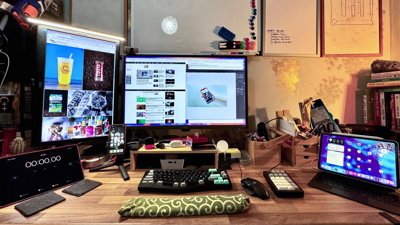A Japanese technology developer has developed 8.3-inch and 13.3-inch OLED displays with an 8K resolution, paving the way for future iPad, iPad Pro, and MacBook models to offer high pixel densities that could even exceed the 1,000 pixel-per-inch milestone.
Semiconductor Energy Laboratory's panels are claimed to have a resolution of 7,680 by 4,320 pixels for both sizes, with the 8.3-inch version refreshing at 60Hz while the 13.3-inch panel can operate at up to 120Hz. On a pixel-per-inch basis, this means the 8.3-inch panel has a pixel density of 1,062, while the larger model offers 663ppi.
For reference, the iPhone XS and iPhone XS Max Retina displays both offer densities of 458ppi, both current iPad Pro models have a modest 264ppi, and the highest-resolution MacBook Pro models are 227ppi.
The method to produce the high-resolution OLED panels use crystalline oxide semiconductor technology, reports Anandtech, specifically with a color filter using CAAC-IGZO material. It is unlikely that any commercial devices will be offering OLED displays using the technology in 2019, as it the designs used are preliminary versions, and would require more work with a manufacturing partner to fully commercialize them.
At its present state, the company has so far demonstrated the 8.3-inch panel in SEMICON Japan in December, though the 13.3-inch OLED has not yet been shown outside the company's facility.
The development of 8K-resolution displays is a natural progression from the 4K panels that are used in televisions and monitors, and in a few smartphones, such as the Sony Z5 Premium. The higher resolutions also offer up more problems for mobile device producers, as more processing and energy resources are required to drive the displays compared to lower-resolution versions, making adapting the technology to mobile platforms tricky.
 Malcolm Owen
Malcolm Owen








 Christine McKee
Christine McKee


 Sponsored Content
Sponsored Content

 Amber Neely
Amber Neely











21 Comments
4K/8K screen is worth for some applications in larger screen like iMAC/PRO, high end monitor but not necessary in iPad, Macbook Pro. Over killed in spec and price. Though one feedback is get rid of that useless OLED touch strip from Macbook Pro. Thanks in advance, Apple.
Do not think Apple will pay for such overkill that no eye can recognize anytime soon if at all.
Shrug....
I have a hard time telling the difference between the screen on my 2014 MacBook Air versus the new Retina displays. And the same with iPhones: I have a hard time seeing the difference in the Xs OLED versus the retina display of the Xr. Yes, there IS a difference. But, for most people and most uses it is not a significant difference.
An OLED MacBook would make for a glittery, shiny new object but would mostly just raise the price more than it would quality. A few would benefit from it but most would not. At the same price it would be a great improvement, But, with a nearly 50% price hike (based on the Xr vs XsMax pricing), it would likely push MacBook sales into being even more of a niche market.
"When introducing the iPhone 4, Steve Jobs said the number of pixels needed for a Retina display is about 300 PPI for a device held 10 to 12 inches from the eye." https://en.wikipedia.org/wiki/Retina_display
...if such is valid is there much of a role for 8K in anything other than a large (40"?) 'pro' display...?
...would bandwidth and heat be possible limitations for portable use...?